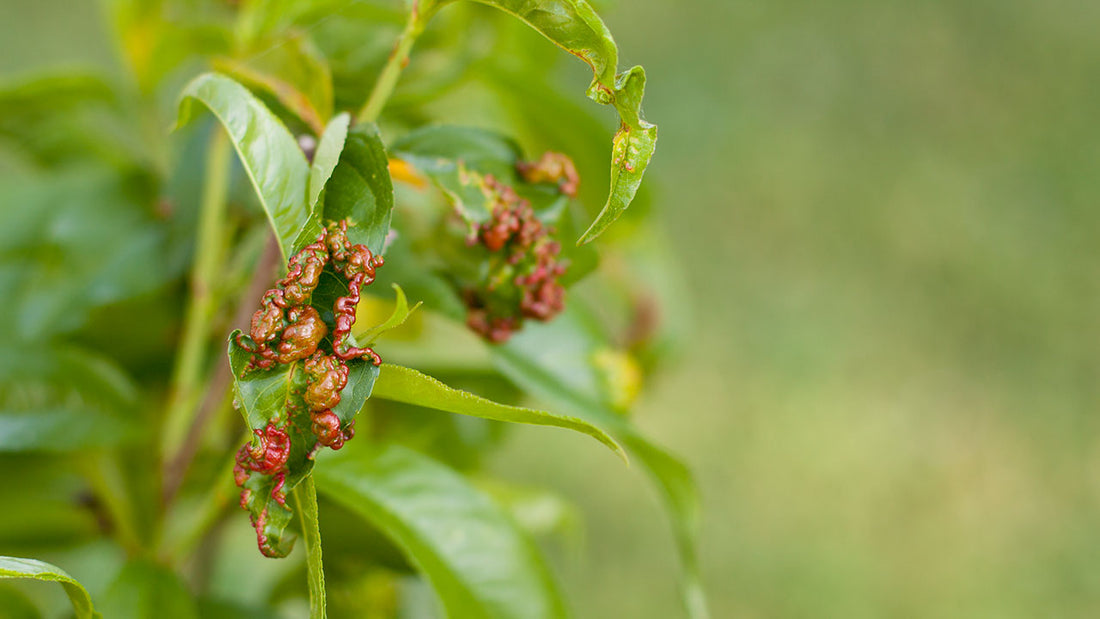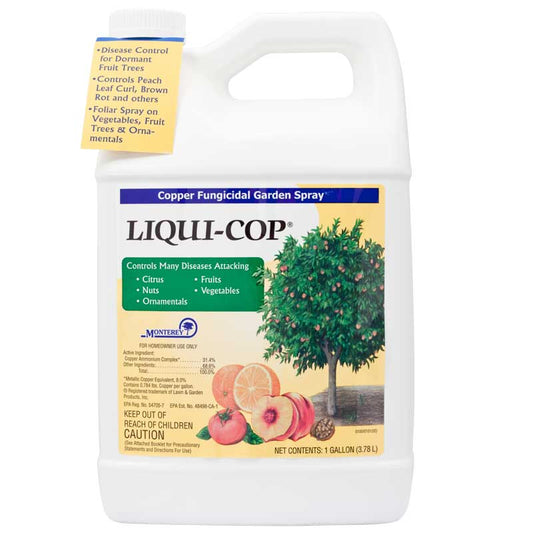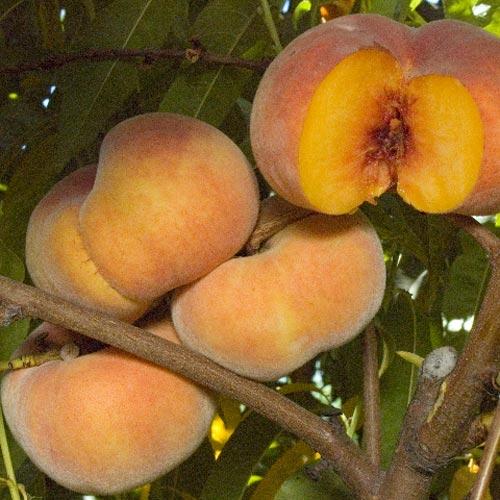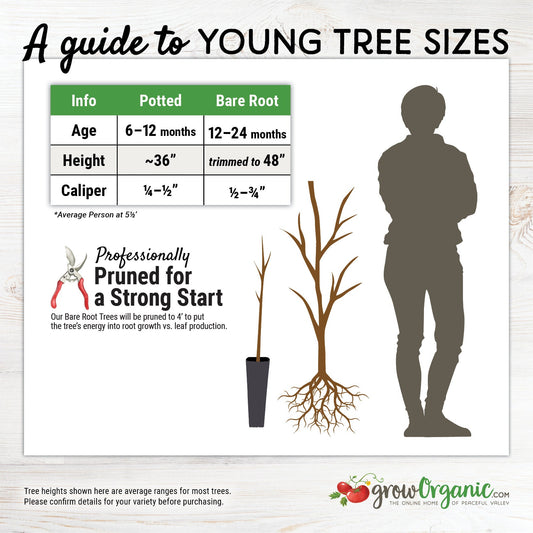What Is Peach Leaf Curl?
Peach leaf curl, also known as curly leaf, curly blight or leaf blister, has been recognized as a common disease since the early 1800s. It is caused by the fungus Taphrina deformans and can affect the blossoms, fruit, leaves and shoots of peaches and nectarines. Peach leaf curl is the most common disease found in backyard orchards. Cool (48-68°F) wet weather when leaves are first opening favors the disease. Watch our video on Peach Leaf Curl where Tricia shows how to care for your trees. 
Life Cycle of the Fungus
Symptoms appear after leaves emerge and begin to grow. The fungus causes cells in the infected portions of the leaves to grow abnormally large, causing the distorted look to the leaves. The fungus eventually produces reproductive bodies called asci that contain the spores. You will see a velvety-like appearance to the leaves, this is caused from the spores or ascospores. They are released into the air and infect other parts of the tree or other trees. In the newly infected areas the fungus continues to multiply and "cover" the tree and remain dormant in the bark and around the buds. The following spring the fungus is moved by rain or irrigation and infects new leaves. And the cycle continues. If not treated, the infection can weaken the tree and cause a decline in fruit production. 
Treatment for Peach Leaf Curl
Chemical controls
Copper
Products available to the home orchardist are those with lower Metallic Copper Equivalent (MCE) of about 8%, such as Liqui-Cop. Effectiveness can be improved with a sticker such as Horticultural Oils. Follow the instructions for all products and make sure you use appropriate safety equipment during application. Apply fungicide to point of runoff and a good rule of thumb is to apply three times during the dormant season: after leaf drop (around Thanksgiving), winter (around Jan.1) and before bud swell (around Feb, depending on where you live). You can apply less often if the infection the previous year was light.
Lime Sulfur
Effective for controlling peach leaf curl but not registered for sale for the backyard orchard and not available for sale in many states.
Cultural Controls
Once the tree is infected there is not much to be done to get rid of the disease that season. But it is very important to maintain the vigor of the tree throughout the active growing season.
- Thin the fruit to reduce the demand on the trees' resources. For peaches and nectarine, thin fruit to at least 3 inches apart. Remove diseased or cracked fruit and place in the trash, not your compost pile.
- Fertilize with nitrogen by mid-June, a good balanced fruit tree fertilizer is a good choice.
- Keep watered to reduce water stress.
- Clean up dropped leaves or fruit around the base of the tree to reduce spreading to other trees. Don't put these in the compost pile, the spores can remain dormant for some time.
Another option, especially if you have to remove a weakened tree, is to consider putting in resistant or partially resistant varieties such as Frost, Indian Free, Muir, or a multigraft peach tree that contains all those varieties. If you don't care for these varieties, choose a tree that blooms later in the season. You may see less disease developing in these due to the later bloom time.
Don't let peach leaf curl ruin your favorite peach or nectarine. Yearly spraying with a fungicide listed for peach leaf curl will keep the disease in check and allow for a healthy tree and a bountiful harvest.





14 comments
I came across a treatment I tried during the growing season. Soak minced onion (I used Egyptian walking onions that were past use) in water, strain and add a few drops of detergent. Spray all over tree. I was amazed at how well it was controlled through the summer. I assume it is the sulfur content of onions.
In spite of spraying with copperoxychloride with a little oil added for greater adherence, my Blackboy Peach, Nectarine and Golden Queen Peach all have leaf curl. The Blackboy Peach is supposed to be pretty resistant to leaf curl. The Golden Queen Peach has much less leaf curl than the Blackboy, but is partly sheltered by the house roof overhang. I sprayed 3x; winter, bud swell and just before bud break. I ruthlessly picked up fallen leaf curl leaves during the past season and I’m continuing to pick them up now. I’m also picking off infected whole leaves and infected portions of leaf. BUT, the infection started at the very tops of my trees, which implies that it has spread from other stone fruit in the area. I’ll try a seaweed spray and hope that it has an effect!
Cesar, your tree should really be planted in full sun, or at least 6-8 hours of sun. You may consider moving the tree to a sunnier location, but do it in the winter when the tree is dormant. If your tree has peach leaf curl, right now there is not much you can do for the tree, other than keep it healthy. In the winter you can spray the tree, as stated in the article and the video.
If I already have fruit growing, what can I do to keep it at bay. I planted the tree 1 year ago and it is now 8 feet tall and not sure what type of peach it is. I have it planted in the corner of my backyard where there is lots of shade in the non spring/summer months, should I move it?
I live in the Seattle area, and purchased two dwarf peach trees of a peach leaf curl-resistant variety (“Frost”), and while very small in stature they have a small yield of developing peaches so far this spring (it’s May).
Over the winter, I purchased another (larger and more established) dwarf peach tree that was supposedly also peach leaf curl-resistant of the “Frost” varietal, thinking that this would actually be the tree that would bear fruit this year, though no flowers ever materialized. However, I’m now seeing evidence of reddish leaf curl on many of the leaves, while the smaller less-established trees remain nearby with small fruits and no evidence of leaf curl.
Does anyone know the smaller trees with no evidence of disease are safe from infection at this point in the growing season, seeing as how leaves and fruits are unaffected? Should I destroy the infected plant so as not to provide a source of spores to the healthy plants? Or perhaps just ride this season out and treat all of them with fungicide in the fall/winter?
Thanks in advance!